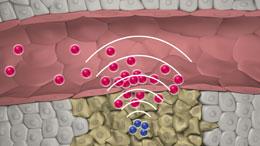By using two types of nanoparticles, drug delivery to tumors could be increased significantly. At the moment, several drug-delivering nanoparticles are already being used in clinical trials to combat tumors. A team at MIT decided to use two distinct particles, each with its own job, one to locate the tumor, and another one to deliver the drugs, all the while making use of the body’s own blood clotting system.
The ‘locator particle’ is a gold nanorod, which fits through the abnormally large pores of tumor blood vessels. When, subsequently, infrared light is shone on those gold particles, they heat up enough to damage the tumor and initiate the blood-clotting cascade. And that’s where the second particle, the ‘receiver particle’, comes into play.
This particle has a protein fragment on its surface that acts as a substrate for an enzyme called Factor XIII, which cross-links with fibrin at the end of the clotting cascade. So, this second particle type is then linked to the fibrin, after which it releases the drugs to fight the tumor (see figure 1).

Figure 1: The 'locater particles' (blue) find the tumor, initiate the clotting cascade and, in doing so, attract the 'receiver particles' (red) that release the drug. (Source: von Maltzahn et al., 2011)
Through using this procedure, a 40-fold increase in the amount of drug delivered could be achieved, when compared to control treatments. And even compared to other nanoparticles, which deliver about 2 to 7 times the amount of drugs, this is a big increase.
This certainly looks promising, but there are some things that still have to be resolved before this approach could be tested in clinical trials. One challenge is to ensure that only the blood clotting process in tumors will result in the attraction of the receiver particles’. Otherwise, any wound could give rise to drug delivery.
Reference
von Maltzahn, G.; Park, J.-H.; Lin, K.Y.; Singh, N.; Schwöppe, C.; Mesters, R.; Berdel, W.E.; Ruoslathi, E.; Sailor, M.J. and Bhatia, S.N. (2011). Nanoparticles that communicate in vivo to amplify tumour targeting. Nature Materials. doi:10.1038/nmat3049.


